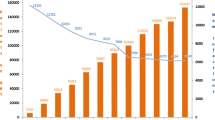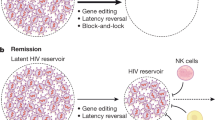Abstract
Highly active antiretroviral therapy (HAART) remains largely unavailable in the developing world. But even with increased availability, HAART is not a silver bullet either for treating or for preventing HIV. Arguably, it is more important than ever to develop and rigorously test innovative interventions to prevent the transmission of HIV. The collection of publications in this issue features the prevention research conducted by the International Program of the Center for AIDS Prevention Studies, University of California at San Francisco. These nine studies offer practical strategies for monitoring the epidemic in all its stages, and suggest affordable prevention approaches in a wide range of settings in the developing world.
Similar content being viewed by others
REFERENCES
Ajuwon, A. J., et al. (2002). HIV-risk-related behavior, sexual coercion, and implications for prevention strategies among female apprentice tailors, Ibadan, Nigeria. AIDS and Behavior, this issue.
Blower, S. M., Gershengorn, H. B., and Grant, R. M. (2000). A tale of two futures: HIV and antiretroviral therapy in San Francisco. Science, 287, 650–654.
Brazilian Ministry of Health. (2000). Coordenacao Nacional de DST/AIDS. Boletim Epidemiologico-AIDS, 2000, 3-56 (available at http://www.aids.gov.br/udtv/link31.htm).
Brazilian Ministry of Health. (2001a). AIDS Drugs Policy-Ministry of Health/Brazil (available at http://www.aids.gov.br/assistencia/aids drugs policy.htm).
Brazilian Ministry of Health. (2001b). Coordenacao Nacional de DST/AIDS. Consenso de Terapia antiretroviral Infantil (available at http://www.aids.gov.br/udtv/link31.htm).
Brocklehurst, P., and Volmink, J. (2002). Antiretrovirals for reducing the risk of mother-to-child transmission of HIV infection. Cochrane Database of Systematic Reviews, 2002, CD003510.
Centers for Disease Control and Prevention. (1999). Increases in unsafe sex and rectal gonorrhea among men who have sex with men-San Francisco, California, 1994-1997. MMWR, 48, 45–48.
Choi, K., et al. (2002). High HIV risk but inadequate prevention services for men in China who have sex with men: An ethnographic study. AIDS and Behavior, this issue.
Connor, E. M., Sperling, R. S., Gelber, R., et al. (1994). Reduction of maternal-infant transmission of human immunodeficiency virus type 1 with zidovudine treatment. New England Journal of Medicine, 331, 1173.
Dickson, D. (2001). Indian company offers cheap anti-AIDS drugs. Nature, 409, 751.
Fritz, K., et al. (2002). The association between alcohol use, sexual risk behavior, and HIV infection among men attending beerhalls in Harare, Zimbabwe. AIDS and Behavior, this issue.
Garcia, P. M., Kalish, L. A., Pitt, J., et al. (1999). Maternal levels of plasma human immunodeficiency virus type-1 RNA and the risk of perinatal transmission. New England Journal of Medicine, 341, 394–402.
Katz, M. H., Schwarcz, S. K., Kellogg, T. A., Klausner, J., Dilley, J. W., Gibson, S., and McFarland, W. (2002). Impact of highly active antiretroviral treatment on HIV seroincidence among men who have sex with men in San Francisco. American Journal of Public Health, 92, 388–394.
Kuhn, L., and Peterson, I. (2002). Twenty-four month efficacy of a maternal short-course zidovudine regimen to prevent motherto-child transmission of HIV-1 in West Africa. AIDS, 8, 631–641.
Kumar, S. (2001). Indian company offers low cost AIDS drugs. Lancet, 357, 616.
Leroy, V., Karon, J. M., Alioum, A., Ekpini, E. R., Meda, N., Greenber, A. I. D., Msellati, P., Hudgens, M., Dabis, F., and Wiktor, S. Z. (2002). Options for prevention of HIV transmission from mother to child, with a focus on developing countries. Paediatric Drugs, 4,191–203.
Mataure, P., et al. (2002). Alcohol use and high-risk sexual behavior among adolescents and young adults in Harare, Zimbabwe. AIDS and Behavior, this issue.
Merchan-Hamann, E., et al. (2002). Prevalence and correlates of HIV-related risk behaviors among adolescents at public schools in Brasilia. AIDS and Behavior, this issue.
Moyo, W., et al. (2002). Impact of a single session of counseling on partner referral for sexually transmitted disease treatment, Harare, Zimbabwe. AIDS and Behavior, this issue.
Musicco, A., Lazzarin, A., Nicolosi, M., et al. (1994). Antiretroviral treatment of men infected with human immunodeficiency virus type 1 reduces the incidence of heterosexual transmission. Archives of Internal Medicine, 154, 1971–1976.
Nabulsi, A. A., Revicki,D., Conway,D., Maurath, C., Mills, R., and Leonard, J. (1998). Quality of life consequences of adding ritonavir to current antiviral therapy for advanced HIV patients. In Programs and abstracts of the International Conference on AIDS, Geneva, Switzerland. Abstract LB.B.6046.
Nemoto, T., et al. (2002). HIV-related risk behaviors among Japanese tourists in the Khaosan Road area, Bangkok, Thailand. AIDS and Behavior, this issue.
Nieuwkerk, P. T., Gisolf, E. H., Colebunders, R., Wu, A. W., Danner, S. A., and Sprangers, M. A., for the Prometheus Study Group. (2000). Quality of life in asymptomatic and symptomatic HIV infected persons in a trial of ritonavir/saquinavir therapy. AIDS, 14, 181–187.
Qu, S., et al. (2002). The potential for rapid sexual transmission of HIV in China: Sexually transmitted diseases and condom use failure highly prevalent among female sex workers. AIDS and Behavior, this issue.
Quinn, T. C., Wawer, M. J., Sewankambo, N., et al. (2000). Viral load and heterosexual transmission of human immunodeficiency virus type 1. New England Journal of Medicine, 342, 921–929.
Ramos, M. C., et al. (2002). Prevention of mother-to-child transmission of HIV: Compliance with the recommendations of the Brazilian National STD/AIDS Control Program for prenatal and perinatal HIV testing in Porto Alegre, Brazil. AIDS and Behavior, this issue.
UNAIDS. (2001a). Accelerating Access to HIV Care, Support, and Treatment (available at http://www.unaids.org/acc access/index.html).
update/report_dec01/index.html).
Vernazza, P. L., Eron, J. J., Fiscus, S. A., and Cohen, M. S. (1999). Sexual transmission of HIV: Infectiousness and prevention. AIDS, 13, 155–166.
Author information
Authors and Affiliations
Corresponding author
Rights and permissions
About this article
Cite this article
McFarland, W., Lindan, C.P., Mandel, J. et al. HIV Prevention in the Developing World: Training Researchers for the Long Haul. AIDS Behav 6, 207–209 (2002). https://doi.org/10.1023/A:1019877206566
Issue Date:
DOI: https://doi.org/10.1023/A:1019877206566




